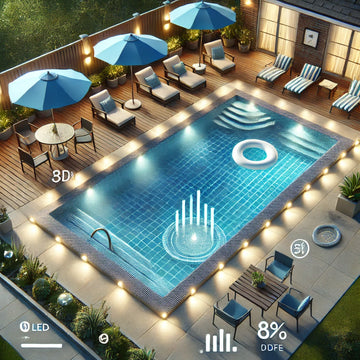A LOOK AT EFFECTIVE POOL WORKOUTS THAT IMPROVE FITNESS AND HEALTH
Pools are a source of entertainment, relaxation, and overall well-being. They’re an escape from the daily stresses and a fun gathering spot for friends and family. And while pools offer many mental health benefits, there are significant physical health benefits to using pools as well.
Many people ask, “Is swimming good exercise?” And the short answer is, yes. But pool exercise isn’t limited to swimming. Aside from water aerobics and swimming laps, there are many other exercises you can benefit from in the pool, like traditional strength and bodyweight workouts.
These popular workouts, also known as aqua training, are effective, low-impact, cross-training workouts. And since they are low-impact, you’re more likely to enjoy and continue these workout routines compared to the more strenuous on-land exercises.
Here’s a look at the many benefits of exercising in the pool along with pool workouts you can add to your swimming workout plan.
THE BENEFITS OF EXERCISING IN THE POOL
Pool workouts are more enjoyable than working out on land. They don’t feel as strenuous as land workouts. Instead of overheating, you can stay cool and refreshed in the water. Splashing around in a pool is way more fun too. And when you enjoy your workouts, you’re more likely to continue working out.
Along with enjoying your workouts, here are the many other benefits to working out in a pool:
- Decreased impact on joints;
- Safer exercises—reduced risk of injury since water’s buoyancy supports body weight;
- Ideal for those recovering from an injury or surgery—exercise and therapeutic benefits of water can reduce healing time;
- Increased resistance in water strengthens muscles, improves cardio intensity, and burns more calories in less time;
- Increased core stability, balance, and agility;
- Improved joint mobility in the hips, spine, and shoulders;
- Enhanced muscular strength and endurance;
- Increased lean body mass;
- Reduced muscle soreness;
- Relief from symptoms of chronic conditions like arthritis, fibromyalgia, and chronic fatigue syndrome (CFS).
WARM-UPS AND BASICS
Before starting your swimming exercises, consider these tips for pool workouts:
- Wear water shoes to improve traction in the pool and to protect your feet from getting sore from uneven pool floors. You can find these online or at your local sporting goods store.
- Only go waist high in the water. Your feet will need to have stable contact with the floor of the pool so your legs can support some of your weight.
- Drink plenty of water. Just like with regular on-land workouts, you need to stay hydrated when working out in the pool. So drink water before, during, and after your workouts.
For an effective cross-training workout, try three to five sets of interval training. Interval training involves timed intervals, usually with 30 seconds of an exercise, followed by 15 seconds of active recovery (e.g. jogging in place).
Here are some basic workouts to start with:
WALKING
Walk one or more laps around the pool, staying in waist-high water. If the pool has a deep end, walk from side to side in the waist-high water instead of around the pool.
Increase your walking speed for every other lap. And try alternating between walking backward and forward.
Walking two laps around a pool is also an excellent way to warm up before starting any workout routine.
HIP ROTATIONS
While holding onto the side of the pool, extend your outer leg to the side. Rotate your leg 3 to 12 times. Then turn around and repeat with the other leg.
When you feel comfortable, try this exercise without holding onto the side of the pool to work on your balance.
JOGGING
Jog in place, keeping your knees high, in intervals of 1 to 3 minutes, followed by less cardio-intensive exercises.
ONE-LEGGED BALANCE
Lift up your left knee and centre a pool noodle under your left foot (it will make a U shape). Balance your left foot on the noodle in front of you for a minute while keeping your hands by your side (or your arms above your head for a greater challenge and core workout). Then move your knee to the side and balance for another minute. Repeat with your right knee and foot.
POOL PLANK
Hold a pool noodle vertically in both hands. While pressing the noodle down into the water lean forward until your body is on an even incline, keeping your head above water. Try to hold this position for 1 to 2 minutes.
MODERATE EXERCISES
As you get stronger, you can include more challenging exercises in your workout routine, such as:
BICYCLE
Hold yourself up with your elbows behind you, resting on the pool edge or on a pool noodle. Then pedal your legs forward in a circular motion as if you were riding a bicycle.
BICEP CURL
Use a pool weight to do bicep curls, keeping the full range of motion under water.
DOUBLE-LEG LIFT
Lean with your back on the pool edge and your arms straight out on each side along the edge. While keeping your legs straight and together, lower your legs straight down, then lift them up as high as you can.
FLUTTER KICK
Hold onto the pool edge, a paddleboard, or a pool noodle in front of you and kick your legs quickly behind you while keeping them under water.
SPIDERMAN
Run your legs up and down the side of the pool while stabilizing your upper body by sweeping your hands and arms back and forth in the water. Do this four times, alternating your leading leg each time.
INTENSE WORKOUTS
For the ultimate pool workout, include these intense workouts in your interval training routine:
CHAOS CARDIO
Run in a zig-zag from one end of the pool to the other. Then run straight through the pool, running through the currents you just created in the water.
JUMP SQUATS WITH PUSH PLATE
Hold a push plate extended in front of your torso, with your hands gripping the handles on each side and your elbows slightly bent. Take a deep breath, jump, and then land in a squat position with your head under water, holding your arms straight in front of you the entire time.
Explode (jump) out of the water as high as possible while still holding the push plate straight in front of you.
KETTLEBELL SWING
Stand in an athletic stance—with your feet shoulder-width apart, your knees slightly bent, your back straight, and your core engaged.
Hold a kettle bell with both hands in front of you. While hinging at the hips, swing the kettlebell between your legs, drive it forward, lift it over your head, and then swing it down between your legs again.
PUSH PLATE CHEST PRESS
Hold a push plate by its handles with the flat side facing you. While standing in an athletic stance with your chest and push plate under water, press the push plate out from your chest and pull it back in quickly and powerfully.
PUSH PLATE ROTATIONS
While in an athletic stance with your feet wider than shoulder-width, hold the push plate with the blade facing you. Engage your core, extend your arms, and submerge the push plate. Rotate your torso side to side as you push and pull the push plate through the water.
SQUAT JUMP
Squat down keeping your arms extended in front of you at shoulder height. Then jump as high as you can while raising your arms upward.
TICK-TOCK HOP
Keeping your feet together, quickly jump from side to side.
Set a goal for how many reps you want to do, and work your way up as you get stronger. An example of a good workout is three to four sets of 15 to 20 reps per set.
For a fulfilling and effective low-impact workout routine, try adding two to three aqua training workouts to your weekly workout schedule. Pool exercises can be way more enjoyable and less straining than on-land exercises. And you’ll still reap the many health and fitness benefits of working out, except while splashing around in a refreshing, relaxing pool.




